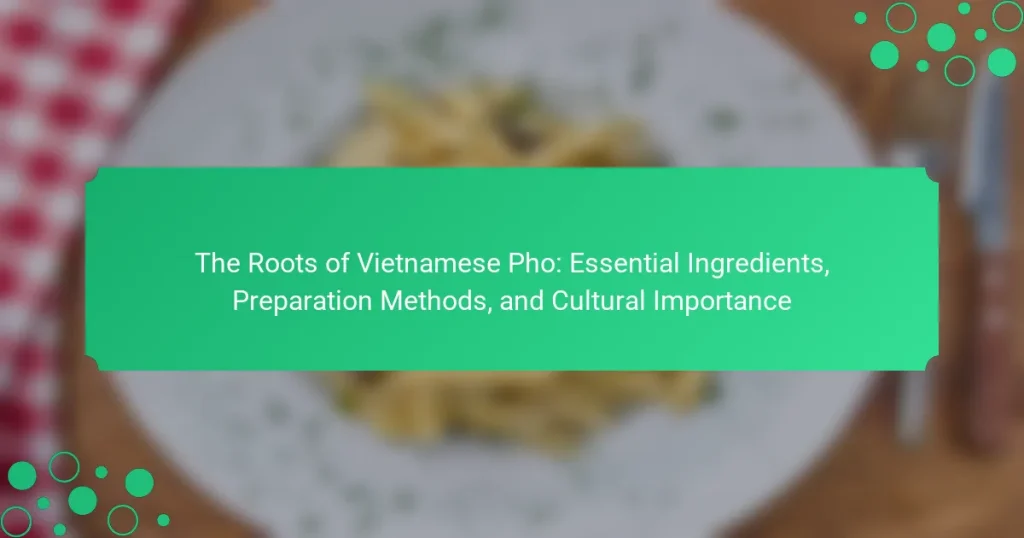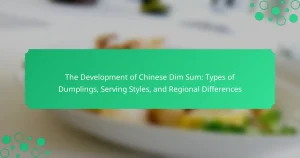Vietnamese Pho is a traditional noodle soup that originates from Vietnam, characterized by its broth, rice noodles, herbs, and typically beef or chicken. This dish, known for its aromatic flavors and garnished with lime, bean sprouts, and fresh herbs, has historical roots dating back to the early 20th century and has evolved into a globally recognized culinary symbol of Vietnamese culture. The preparation of Pho involves traditional methods passed down through generations, highlighting its cultural significance and communal dining associations. Modern adaptations, such as vegan and gluten-free versions, reflect Pho’s versatility while maintaining its core essence, appealing to diverse dietary preferences and tastes. The article explores the essential ingredients, preparation methods, and the cultural importance of Vietnamese Pho, illustrating its role as a national dish and its impact on global cuisine.

What is Vietnamese Pho?
Vietnamese Pho is a traditional noodle soup originating from Vietnam. It consists of broth, rice noodles, herbs, and meat, typically beef or chicken. The dish is known for its aromatic flavors and is often garnished with lime, bean sprouts, and fresh herbs. Pho has historical roots dating back to the early 20th century in northern Vietnam. It has since evolved into a popular dish worldwide. The unique combination of spices and cooking techniques contributes to its distinct taste. Pho is not only a meal but also a cultural symbol in Vietnamese cuisine.
How did Vietnamese Pho originate?
Vietnamese Pho originated in the early 20th century in northern Vietnam. It was influenced by French colonialism and local culinary traditions. The dish combines beef or chicken broth with rice noodles and herbs. The word “pho” is derived from the French word “pot-au-feu,” meaning pot of stew. Initially, it was served as a street food in Hanoi. Over time, Pho evolved into a national dish of Vietnam. Historical accounts suggest it gained popularity after World War I. Today, Pho is enjoyed worldwide, symbolizing Vietnamese cuisine.
What historical influences shaped the development of Pho?
Pho developed from a blend of French colonial influence and traditional Vietnamese cuisine. French colonization introduced beef as a primary ingredient, as well as the use of stock in cooking. Vietnamese culinary practices, including the use of rice noodles and herbs, contributed to the dish’s unique flavor profile. The combination of these influences created a distinct broth, which became the foundation of pho. Historical records indicate that pho emerged in the early 20th century in Northern Vietnam, particularly in Hanoi. The dish gained popularity through street vendors and has since evolved into a national symbol of Vietnamese cuisine.
How has Pho evolved over time in Vietnam?
Pho has evolved significantly over time in Vietnam. Originally, Pho was influenced by French cuisine in the early 20th century. The dish began as a simple beef broth with rice noodles and was often served with herbs. Over decades, Pho incorporated various regional ingredients and flavors. The use of spices like star anise and cinnamon became common in the broth. Additionally, different regions in Vietnam developed their own versions of Pho, such as Pho Bac in the north and Pho Nam in the south. The popularity of Pho surged during the Vietnam War, leading to its global recognition. Today, Pho is a symbol of Vietnamese culture and is enjoyed worldwide.
What are the essential ingredients of Vietnamese Pho?
The essential ingredients of Vietnamese Pho include rice noodles, broth, and meat. Rice noodles, known as bánh phở, are flat and made from rice flour. The broth is typically beef or chicken-based, simmered for hours with spices like star anise and cinnamon. Common meats used are beef slices, brisket, or chicken. Fresh herbs such as basil and cilantro enhance the flavor. Additionally, bean sprouts and lime are often served as garnishes. These ingredients create a harmonious blend, making Pho a beloved dish in Vietnamese cuisine.
What types of broth are used in Pho?
Pho typically uses two main types of broth: beef broth and chicken broth. Beef broth is made by simmering beef bones, herbs, and spices for several hours. This process extracts deep flavors and nutrients, creating a rich base for the dish. Chicken broth, on the other hand, is lighter and made from chicken bones and meat. It provides a different flavor profile, often preferred for a milder taste. Both broths serve as the foundation for Pho, allowing for variations in flavor and texture. The choice of broth can significantly influence the overall experience of enjoying Pho.
Which herbs and spices are crucial for authentic Pho flavor?
Coriander, basil, and star anise are crucial for authentic Pho flavor. Coriander adds a fresh, citrusy note. Thai basil provides a slightly spicy and sweet flavor. Star anise contributes a warm, licorice-like taste. Other important ingredients include cloves, cardamom, and cinnamon. Cloves offer a rich aroma, while cardamom adds complexity. Cinnamon enhances the overall depth of flavor. These herbs and spices create a harmonious balance in Pho broth, essential for authenticity.
What are the different types of noodles used in Pho?
Pho primarily uses rice noodles, specifically known as bánh phở. Bánh phở are flat and wide rice noodles. They are made from rice flour and water. These noodles are essential for the traditional pho dish. Another type of noodle sometimes used is egg noodles, known as mì. Mì are thinner and have a different texture compared to bánh phở. However, bánh phở remains the most authentic choice for pho. The use of these noodles contributes to the unique flavor and texture of the dish.
How is Vietnamese Pho traditionally prepared?
Vietnamese Pho is traditionally prepared by simmering beef bones for several hours to create a rich broth. This broth is flavored with spices such as star anise, cloves, and cinnamon. Fresh herbs, including cilantro and green onions, are added for aroma. Rice noodles are cooked separately and then placed in bowls. The hot broth is poured over the noodles. Thinly sliced beef is often added raw, cooking in the heat of the broth. Pho is typically served with lime wedges, bean sprouts, and chili peppers on the side for customization. This preparation method highlights the balance of flavors and textures that define traditional Pho.
What are the steps involved in making Pho broth?
To make Pho broth, first, gather the essential ingredients. These include beef bones, ginger, onion, and spices like star anise and cinnamon. Next, roast the ginger and onion until charred. This step enhances the broth’s flavor. Then, place the beef bones in a large pot and cover them with water. Bring the water to a boil and then reduce to a simmer. Skim off any impurities that rise to the surface. After that, add the roasted ginger, onion, and spices to the pot. Allow the broth to simmer for several hours, typically around six to eight hours. This long cooking time extracts the deep flavors from the bones and spices. Finally, strain the broth to remove solids, resulting in a clear, flavorful liquid ready for serving.
How do you assemble a bowl of Pho?
To assemble a bowl of Pho, start with a base of cooked rice noodles. Layer the noodles in a bowl, ensuring they are evenly distributed. Next, add a generous portion of thinly sliced meat, typically beef or chicken. Pour hot, flavorful broth over the noodles and meat. The broth should be aromatic, infused with spices like star anise and cinnamon. Garnish the bowl with fresh herbs, such as basil and cilantro. Add bean sprouts and lime wedges for extra flavor and texture. Finally, include condiments like hoisin sauce and sriracha on the side. Each element contributes to the overall taste and experience of Pho.

What cultural significance does Vietnamese Pho hold?
Vietnamese Pho holds significant cultural importance as a national dish of Vietnam. It represents the country’s culinary heritage and identity. Pho is often associated with communal dining and family gatherings. It reflects the fusion of various cultural influences, including French and Chinese cuisines. The dish symbolizes comfort and warmth in Vietnamese culture. Pho is commonly enjoyed for breakfast, showcasing its role in daily life. Additionally, it has gained international recognition, promoting Vietnamese culture globally. The preparation of Pho involves traditional methods that have been passed down through generations, reinforcing its cultural significance.
Why is Pho considered a national dish of Vietnam?
Pho is considered a national dish of Vietnam due to its cultural significance and historical roots. It reflects the country’s culinary heritage, blending influences from Chinese and French cuisines. Pho is characterized by its flavorful broth, rice noodles, and various meats, typically beef or chicken. The dish is often enjoyed as a breakfast staple across Vietnam. Its popularity has led to its recognition as a symbol of Vietnamese identity. The preparation of pho involves meticulous methods, including simmering bones for hours to achieve depth of flavor. Furthermore, pho is celebrated in Vietnamese festivals and gatherings, reinforcing its status as a beloved dish. The dish’s global recognition has also contributed to its national status, with many restaurants worldwide serving authentic pho.
How does Pho reflect Vietnamese culinary traditions?
Pho reflects Vietnamese culinary traditions through its use of local ingredients and cooking techniques. The dish typically features rice noodles, beef or chicken, and a fragrant broth. These ingredients highlight the importance of fresh produce and herbs in Vietnamese cuisine. The preparation method involves simmering bones for hours to create a rich, flavorful broth. This slow cooking process showcases the Vietnamese emphasis on depth of flavor. Additionally, pho is often served with fresh herbs, lime, and chili, which reflects the balance of flavors in Vietnamese dishes. The communal aspect of sharing pho also underscores the cultural significance of food in Vietnamese society. Overall, pho embodies the essence of Vietnamese culinary practices through its ingredients, preparation, and cultural context.
What role does Pho play in Vietnamese social gatherings?
Pho serves as a central dish in Vietnamese social gatherings. It represents hospitality and community. Sharing a bowl of pho fosters connection among family and friends. The dish is often prepared for celebrations and gatherings. It is common during holidays like Tet, the Lunar New Year. Pho’s rich flavors and aromas create a warm atmosphere. The act of eating together strengthens social bonds. This cultural significance highlights pho’s role beyond mere sustenance.
How is Pho enjoyed in different regions of Vietnam?
Pho is enjoyed differently across various regions of Vietnam. In the north, particularly Hanoi, pho is typically served with a clear broth, flat rice noodles, and minimal garnishes. The focus is on the beef or chicken flavor. In central Vietnam, especially in Hue, pho features a spicier broth and may include additional herbs and toppings like chili and lime. The southern region, including Ho Chi Minh City, often has a sweeter broth and is served with a wider array of garnishes such as bean sprouts, herbs, and lime. Each region’s unique preparation reflects local tastes and ingredients, showcasing Vietnam’s diverse culinary landscape.
What are the regional variations of Pho across Vietnam?
Pho varies significantly across Vietnam, with each region offering unique flavors and ingredients. Northern Pho, particularly from Hanoi, features a clear broth, flat rice noodles, and minimal garnishes. It often emphasizes beef, with cuts like brisket and sirloin. In central Vietnam, especially in Hue, Pho includes a spicier broth and often incorporates herbs and chili. It may also feature a wider variety of meats, including pork. Southern Pho, primarily from Ho Chi Minh City, is known for its sweeter broth and generous toppings, including bean sprouts and fresh herbs like basil and cilantro. Each regional variation reflects local tastes and culinary traditions.
How do local ingredients influence the taste of Pho in various areas?
Local ingredients significantly influence the taste of Pho across various regions. In northern Vietnam, Pho often features fresh herbs like cilantro and green onions. These ingredients contribute a lighter, fresher flavor profile. In central Vietnam, the use of chili peppers and lemongrass adds a spicy and aromatic dimension. Southern Vietnam tends to incorporate sweeter elements, such as bean sprouts and lime, creating a more complex taste. Regional variations in beef quality and broth preparation also affect the overall flavor. For example, the use of different cuts of meat can alter the richness of the broth. Additionally, local water quality may impact the final taste of the dish. These regional adaptations reflect the diverse culinary landscape of Vietnam.

What modern adaptations of Vietnamese Pho exist?
Modern adaptations of Vietnamese Pho include variations that cater to dietary preferences and global flavors. Examples are vegan Pho, which uses vegetable broth and plant-based proteins. Gluten-free Pho replaces traditional noodles with rice noodles or alternatives. Fusion Pho combines elements from other cuisines, such as Pho tacos or Pho ramen. Regional adaptations exist, like the addition of local spices or ingredients. These adaptations maintain the core essence of Pho while appealing to diverse tastes. The popularity of Pho has led to its evolution in various culinary contexts.
How has Pho been incorporated into international cuisine?
Pho has been incorporated into international cuisine through its adaptation in various culinary cultures. Many countries have embraced pho, creating their own versions that reflect local tastes. In the United States, pho has gained popularity in urban areas, often served in casual dining settings. Restaurants frequently offer unique twists, such as fusion flavors or ingredient substitutions. In Australia, pho is featured in a diverse range of eateries, highlighting its versatility. Additionally, chefs worldwide experiment with pho’s traditional components, like broth and noodles, to create innovative dishes. This global acceptance showcases pho’s influence beyond Vietnamese borders, making it a staple in international dining.
What fusion dishes have emerged from traditional Pho?
Fusion dishes that have emerged from traditional Pho include Pho Tacos and Pho Pizza. Pho Tacos feature marinated beef or chicken, fresh herbs, and broth-infused sauces wrapped in tortillas. Pho Pizza combines traditional Pho toppings like beef, bean sprouts, and herbs on a pizza crust, often with a broth-inspired sauce. These dishes reflect innovative culinary adaptations while maintaining the essence of Pho. The blending of Vietnamese flavors with other cuisines showcases the versatility and popularity of Pho in modern gastronomy.
How do modern cooking techniques alter the preparation of Pho?
Modern cooking techniques significantly alter the preparation of Pho by introducing time-saving methods and enhanced flavor extraction. Sous-vide cooking allows for precise control of temperature, ensuring consistent broth quality. Pressure cooking reduces the time needed to achieve rich flavors in the broth. Immersion blenders create smooth textures in sauces and garnishes. Additionally, modern spice infusers help in evenly distributing flavors without the need for lengthy simmering. These techniques maintain the traditional essence of Pho while making the process more efficient and accessible.
What tips can enhance your Pho experience at home?
Use fresh ingredients for your Pho to enhance flavor. Fresh herbs like basil and cilantro elevate the dish. High-quality broth is crucial; simmer bones for hours to extract rich flavors. Customize your Pho with various proteins such as beef, chicken, or tofu. Add toppings like bean sprouts and lime for texture and acidity. Serve with rice noodles cooked just right for the perfect bite. Adjust seasoning with fish sauce and chili for personal taste. These elements create a more authentic and enjoyable Pho experience at home.
How can you achieve authentic Pho flavors in your cooking?
To achieve authentic Pho flavors in your cooking, focus on using high-quality ingredients. Start with a rich beef or chicken broth, simmering bones for several hours to extract deep flavors. Use spices like star anise, cloves, and cinnamon to create a fragrant base. Incorporate fresh herbs such as basil and cilantro, which are essential for traditional Pho. Select rice noodles that are specifically designed for Pho, ensuring the right texture. Finally, serve with lime wedges and bean sprouts for added freshness. These steps align with traditional Vietnamese cooking practices, ensuring an authentic Pho experience.
What common mistakes should you avoid when making Pho?
Common mistakes to avoid when making Pho include using low-quality broth. A rich, flavorful broth is essential for authentic Pho. Failing to simmer the broth long enough can result in a weak flavor. Traditional Pho broth should simmer for at least 6-8 hours. Additionally, not using the right spices can diminish the dish’s authenticity. Key spices include star anise, cloves, and cinnamon, which should be toasted for maximum flavor. Overcooking the noodles is another frequent error. Rice noodles should be cooked just until tender, as they continue to soften in the hot broth. Lastly, neglecting to balance toppings can lead to an unbalanced dish. Fresh herbs, lime, and chili should be used generously to enhance flavor.
Vietnamese Pho is a traditional noodle soup that originated in northern Vietnam in the early 20th century, characterized by its aromatic broth, rice noodles, herbs, and typically beef or chicken. The article explores the historical influences that shaped Pho, including French colonialism, and details the essential ingredients and preparation methods that contribute to its distinct flavor. It also highlights the cultural significance of Pho as a national dish, its regional variations across Vietnam, and modern adaptations that cater to diverse tastes. Additionally, the article provides insights into enhancing the Pho experience at home, including tips for achieving authentic flavors and avoiding common mistakes.




